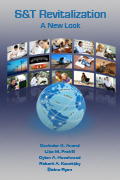S&T Revitalization
A New Look
D.K. Anand, L. Frehill, D. Hazelwood,
R. Kavetsky, and E. Ryan
ISBN 978-0-9846274-5-5
CALCE EPSC Press, University of Maryland, College Park, MD, 2012
|
The issues impacting S&T revitalization and the supply of S&Es are complex and do not usually lend themselves to easy or straightforward solutions. Considering that the United States used to lead the world in the percentage of adults with college degrees but has now fallen to 10th place, and that the outlook for America’s ability to compete for jobs in the global economy has continued to deteriorate in the last five years, we need to address this issue and reverse it by a sustained investment in education and basic research to keep from slipping further. |
|
|---|
The revitalization of S&T was examined six years ago in a CECD book entitled From Science to Seapower: A Roadmap for S&T Revitalization, in which ten recommendations were made. The emphasis in this study was primarily on S&T policy issues affecting the U.S. Navy Labs. These recommendations were revisited in a subsequent edition, Postscript 2010. The fact remains that the total number of students graduating with a bachelor’s degree in engineering in the United States continues to drop as a percentage of the total number of bachelor’s degrees awarded. With this in mind, we propose to re-examine the issue of workforce revitalization and to focus, explicitly, on the supply of engineers as it is affected by culture, immigration, demographics, and globalization.
Our primary purpose in writing this book is to generate a discussion at the national level regarding how best the U.S. can ensure the vitality of the engineering workforce in the coming century. We feel strongly that our engineers need to be well prepared technically, be connected in a meaningful way to the global science and engineering world, and be gender and ethnically diverse and bilingual in order to enhance connectivity with the global S&E community both technically and culturally.
Contact Ania Picard at picard@cecd.umd.edu to order a copy of this book.
Contents
Chapter 1 Introduction
Chapter 2 The Cultural Factor
Chapter 3 Immigration
Chapter 4 Under-Represented Groups
Chapter 5 Globalization
Chapter 6 Conclusions and Recommendations
Appendix The Community Speaks


